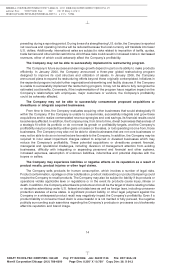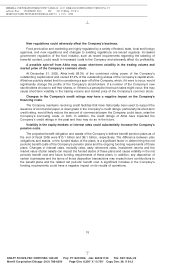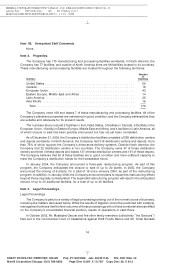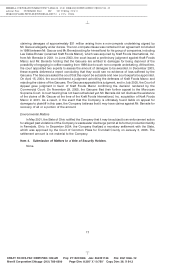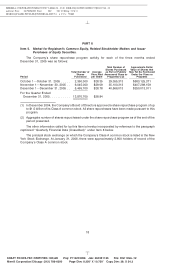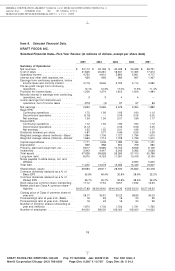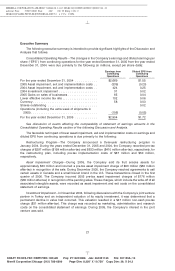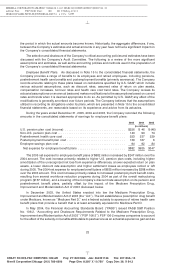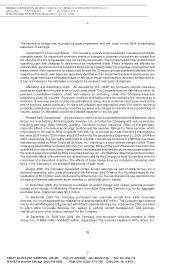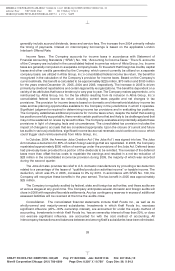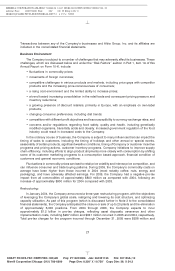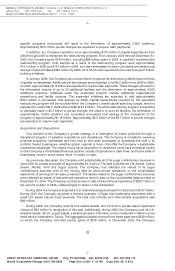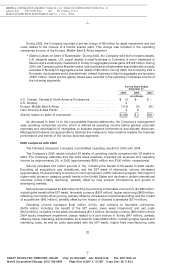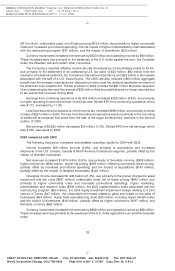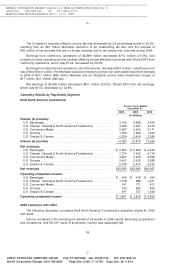Kraft 2005 Annual Report Download - page 25
Download and view the complete annual report
Please find page 25 of the 2005 Kraft annual report below. You can navigate through the pages in the report by either clicking on the pages listed below, or by using the keyword search tool below to find specific information within the annual report.
MERRILL CORPORATION ABLIJDE// 7-MAR-06 14:42 DISK126:[06CHI5.06CHI1135]DI1135A.;10
mrll.fmt Free: 190D*/240D Foot: 0D/ 0D VJ RSeq: 5 Clr: 0
DISK024:[PAGER.PSTYLES]UNIVERSAL.BST;51
KRAFT FOODS-FSC CERTIFIED-10K/AR Proj: P1102CHI06 Job: 06CHI1135 File: DI1135A.;10
Merrill Corporation/Chicago (312) 786-6300 Page Dim: 8.250 X 10.750Copy Dim: 38. X 54.3
a reduction of the service cost component of net postretirement health care costs for amounts
attributable to current service, if the benefit provided is at least actuarially equivalent to Medicare Part D.
The Company adopted FSP 106-2 in the third quarter of 2004. The impact for 2005 and 2004 was a
reduction of pre-tax net postretirement health care costs and an increase in net earnings of $55 million
and $24 million, respectively. In addition, as of July 1, 2004, the Company reduced its accumulated
postretirement benefit obligation for the subsidy related to benefits attributed to past service by
$315 million and decreased its unrecognized actuarial losses by the same amount.
At December 31, 2005, for the U.S. pension and postretirement plans, the Company reduced its
discount rate assumption from 5.75% to 5.60%. The Company presently anticipates that assumption
changes, coupled with the amortization of deferred gains and losses will result in an increase in 2006
pre-tax benefit expense of approximately $80 million, or approximately $0.03 per share. The expected
increase in benefit expense is prior to the consideration of any impact of the expanded restructuring
program. While the Company does not presently anticipate a change in its 2006 assumptions, as a
sensitivity measure, a fifty-basis point decline (increase) in the Company’s discount rate would increase
(decrease) the Company’s U.S. pension and postretirement expense by approximately $72 million.
Similarly, a fifty-basis point decrease (increase) in the expected return on plan assets would increase
(decrease) the Company’s pension expense for the U.S. pension plans by approximately $31 million.
See Note 15 to the consolidated financial statements for a sensitivity discussion of the assumed health
care cost trend rates.
Revenue Recognition. As required by U.S. GAAP, the Company recognizes revenues, net of sales
incentives, and including shipping and handling charges billed to customers, upon shipment or delivery
of goods when title and risk of loss pass to customers. Shipping and handling costs are classified as part
of cost of sales. Provisions and allowances for estimated sales returns and bad debts are also recorded
in the Company’s consolidated financial statements. The amounts recorded for these provisions and
related allowances are not significant to the Company’s consolidated financial position or results of
operations.
Depreciation, Amortization and Goodwill Valuation. The Company depreciates property, plant and
equipment and amortizes definite life intangibles using the straight-line method over the estimated
useful lives of the assets.
The Company is required to conduct an annual review of goodwill and intangible assets for potential
impairment. Goodwill impairment testing requires a comparison between the carrying value and fair
value of each reporting unit. If the carrying value exceeds the fair value, goodwill is considered impaired.
The amount of impairment loss is measured as the difference between the carrying value and implied fair
value of goodwill, which is determined using discounted cash flows. Impairment testing for
non-amortizable intangible assets requires a comparison between the fair value and carrying value of
the intangible asset. If the carrying value exceeds fair value, the intangible asset is considered impaired
and is reduced to fair value. These calculations may be affected by the market conditions noted below in
the Business Environment section, as well as interest rates, general economic conditions and projected
growth rates. During the first quarter of 2005, the Company completed its annual review of goodwill and
intangible assets and no impairment charges resulted from this review. However, as part of the sale or
pending sale of certain Canadian assets and two brands, the Company recorded non-cash pre-tax asset
impairment charges of $269 million in 2005, which included impairment of goodwill and intangible
assets of $13 million and $118 million, respectively, as well as $138 million of asset write-downs. During
2004, the Company’s annual review of goodwill and intangible assets resulted in a $29 million non-cash
pre-tax charge related to an intangible asset impairment for a small confectionery business in the United
States and certain brands in Mexico. A portion of this charge, $17 million, was reclassified to earnings
from discontinued operations on the consolidated statement of earnings in the fourth quarter of 2004.
24
6 C Cs: 13586


